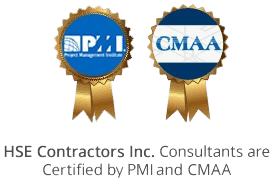Shutdown/Turnaround Scheduler
Shutdown projects, also known as turnarounds, planned outages or STOs are a distinctive and demanding type of project. Stakes are high, as is pressure on the schedule and project team. They are typically costly, short in duration, high risk, require a large number of human resources (including a substantial proportion of sub-contractors), and have a significant focus on HSE (health, safety, and environment). The complexity of these projects dictates a sound process for planning and executing. Meanwhile, the pressure on schedule and overall duration turn them into the Formula 1 of project execution and control.
40% of shutdown projects experience a cost overrun or schedule delay of more than 30%. But what are the main differences between shutdown projects and regular projects? And what do these differences tell us about the best way to approach scheduling?
Shutdown Projects vs Regular Projects: Key Differences
Some of the main differences, particularly in relation to scheduling are:
- Turnarounds are periodic and can be carried out only when the plant (asset) is taken out of service. Scheduling pressure is greatly intensified as the value of the project is measured by opportunity cost. A schedule overrun of a day means a day of lost output, which can equate to huge sums of money.
- The schedule is very closely bound to the defined scope of work.
- Extensive sub-contracting is much more common in shutdown projects. It’s not uncommon to see the number of people on site grow by 300 % during shutdowns.
- Shutdown projects often comprise a higher proportion of unplanned work. It can be difficult to predict exactly what will be required after equipment is inspected, especially if for the first time. However, once a shutdown project has been done once, many of the planned activities will actually be repeated – when the shutdown is next repeated.
- Schedules need to be planned to a much more granular level (sometimes down to the minute) and updated more frequently – often on a shift-by-shift basis.
Turbines, Boilers, Expellers, Vibratory Conveyors & ABB Controls
Depending on the type of plant, HSE has experience and understanding of how to sequence the work among many moving industrial machinery which includes but is not limited to the following:
- Turbines – Always on the critical path as they have a lot of risk and must be sequenced properly
- Boilers which are usually above Expellers
- Water walls which are above Expellers
- Vibratory Converters that may be installed for the length of the plant
- Expeller Control Panels
- Scaffolding
- Turbine Diagnostic Services
- Central Maintenance and Welding
- Cooling Towers
- Vibratory Conveyers
- Testing and commissioning of ABB Controls
The Planning Phase
In a presentation by maintenance planning and scheduling specialists, Richard Palmer and Associates, they highlight the substantial value in performing proper planning in shutdowns via an industry rule of thumb: one US dollar invested in proper maintenance can equate to ten dollars in plant profit.
1. Scope Management
As in EPCI projects, one of the most common causes of project overruns is scope creep. So, the scope of work should be defined and agreed upon well in advance. During the early planning phase, the entire potential scope of work should be challenged. Ask yourself:
- Does this task have to be performed during the shutdown? Or could it be done during regular operation of the plant?
- Do the benefits of extending this scope of work by a day outweigh the costs of another’s days lost production? From a business standpoint, it’s important the prioritised work is carried out during the shutdown and the off-line period is kept as short as possible.
Until it’s finally frozen, the scope of work for the STO is likely to fluctuate. To manage changes to the scope of work and to manage the project planning process, a scope change-control process must be in place. It’s also important to identify all work that can and needs to take place prior to shutting down the plant, as well as the work required after start-up. This is required to keep the amount of work during the stop period to a minimum.
2. The STO Schedule: Work Preparation
Once the scope of work is finalised and verified, the STO team can create a total integrated schedule, including all work to be performed. The schedule should include: all sub-contractor work, all activities related to shutting down the plant safely in preparation for the STO, and the activities needed to restart the plant.
The sequence of work should also take into account any restrictions. For example, needing to have a hydrocarbon-free environment before starting any hot work. The upshot, in this case, would be that mechanical work should start earlier than hot work.
As the schedule starts developing, the schedulers can identify and focus on optimizing the longest path. The scheduling team will also evaluate resource demands by area, unit, sub-contractors, and more.
Focus should be given to: site access, the maximum number of people at any time in any area, and demand vs available resources. If your STO project is related to an offshore oil facility, you will need to add the extra constraint of bed capacity, as this directs the maximum number of people allowed onto the platform.
The pre-shutdown work should be planned, scheduled, executed, and monitored closely to ensure it’s all completed before shutting down the plant. The scheduling team should aim to challenge and optimize the different phases of the project execution:
- Shutdown
- Execution of the STO work
- Testing
- Preparations and run-up to bring the plant successfully and safely back to full operation
The scheduling team should also focus on status reporting, status meetings, and all required routines to plan for a successful execution. Ideally, they will prepare project status reports containing S-curves, manpower histograms, progress summaries, and bar charts – with front-lines that clearly identify status, and have the capacity to reveal any deviations that occur.
Each report should have the following objective:
- Only a few pages (between around one and three) in length
- Narrow and specific in focus
- Simple and easy to read
- Easily available – web-based reporting is ideal
- Automatically produced at regular intervals
The structure of the schedule and supporting codes should be flexible enough to allow reports to be produced for any area, unit, contractor, sub-contractor, and any defined phase or sub-phase, as well as overall for the STO project. You may well be asked to prepare a set of one hundred or more reports, on a daily basis, to support the needs of the different stakeholders. To do this, you need a powerful and flexible project management process with extensive reporting capabilities.
HSE is responsible for generating and maintaining the T/A P6 schedule, including all necessary logic and relationships to ensure we have a schedule driven outage with dynamic calculation of critical path jobs. HSE is also responsible for including change orders and added scope to the schedule during the outage, as well as post-outage reviews of the schedule. HSE assists with support and implementation of maintenance improvements during non-TA times.
The Scheduler will perform a variety of tasks related to the project set up; cost control; and the tracking and forecasting of costs related to each individual projects’ life cycle. Scheduler will walk down scope, verify progress, and coordinate with all parties to ensure the schedule reflects proper status and forecast.
HSE’s scope includes but it’s not limited to the following tasks:
- Create and maintain the P6 schedule for plant outages and T/A’s, including detailed critical path tracking
- Work with operations and staff to determine required task and work order logic for schedule
- Incorporate AWR scope and added work orders to the schedule during the outages
- Create and maintain FCO and extras log during outages and T/A’s
- Generate required reports from P6 to allow for daily execution updates and progress report distribution
- Backup and assist others in Project Services during non-T/A windows
- Assist with support and implementation of maintenance improvement projects
- Capable of working on multiple priorities simultaneously.
HSE understands that there must be some physical requirements that are needed such as:
- The right resource will be required to adhere to large amounts of standing, walking, bending, squatting, sitting and lifting.
- Will use arms and hands to signal, grab, hold, turn, push, and pull: objects, materials, controls and tools.
- May be required to pick up, lift, carry and move up to 50lbs.
- Will work at heights, climb ladders and stairways, and may occasionally work off of platforms/scaffolding using the appropriate fall protection requirements.
- Must be able to work in all weather conditions (including heat, rain, cold and wind) while wearing appropriate PPE.
- Will be required to wear personal protective equipment (PPE) including but not limited to: hard hat, safety glasses/spoggles, ear plugs, masks/respirators, hi-vis safety vests, leather gloves and leather steel-toed work boots.
HSE has the right staff for your shut down or turn around job as our shutdown/Turn Around schedulers have the following experience and are ready to go anywhere
- Deep knowledge and understanding of Industrial Drawings
- Minimum of (10+) years of related work experience.
- Very proficient with Microsoft and Primavera P6.
- Have experience with IPS (Advance Scheduling Module).
- Have experience with Job Cost and Procore.
- Extreme attention to detail.
- Ability to set priorities.
- Strong presentation skills.
- Understanding and knowledge of schedule constraints and requirements to produce all project control deliverables.
- Have a valid Driver’s License and can easily pass security clearance.
- Are able to pass drug and background check.
HSE has no problem with horsepower as we can assign multiple resources to work on any project concurrently to cut the turn-around time into half at no additional cost especially during shut downs.
To learn more about how HSE can quickly turn around your project, contact us today
Contact Us
Additional Services

Contact Us
Call Us 1-888-398-8283 Our LocationsEmail us for more info about our Construction Scheduling Services
Let Us Contact You
Download our Brochures
Flagship ProjectsMulti-Family Residential Projects
Waste Water & Used Oil Treatment
Residential Projects
Roadways & Bridges Projects
High-rise Projects
Federal Projects
Airport Projects
Commercial Projects
View our Work Samples
4d Modeling SamplesCPM Schedule Report Sample

Call Our CPM Scheduling Consultants
Our offices in Orlando, New York City, Boston, Los Angeles, San Francisco, Miami, Tampa, Chicago, Denver, Brooklyn, Dallas and Washington, DC, Offer Innovative and efficient solutions on a variety of construction projects nationwide, Contact Us Today!


